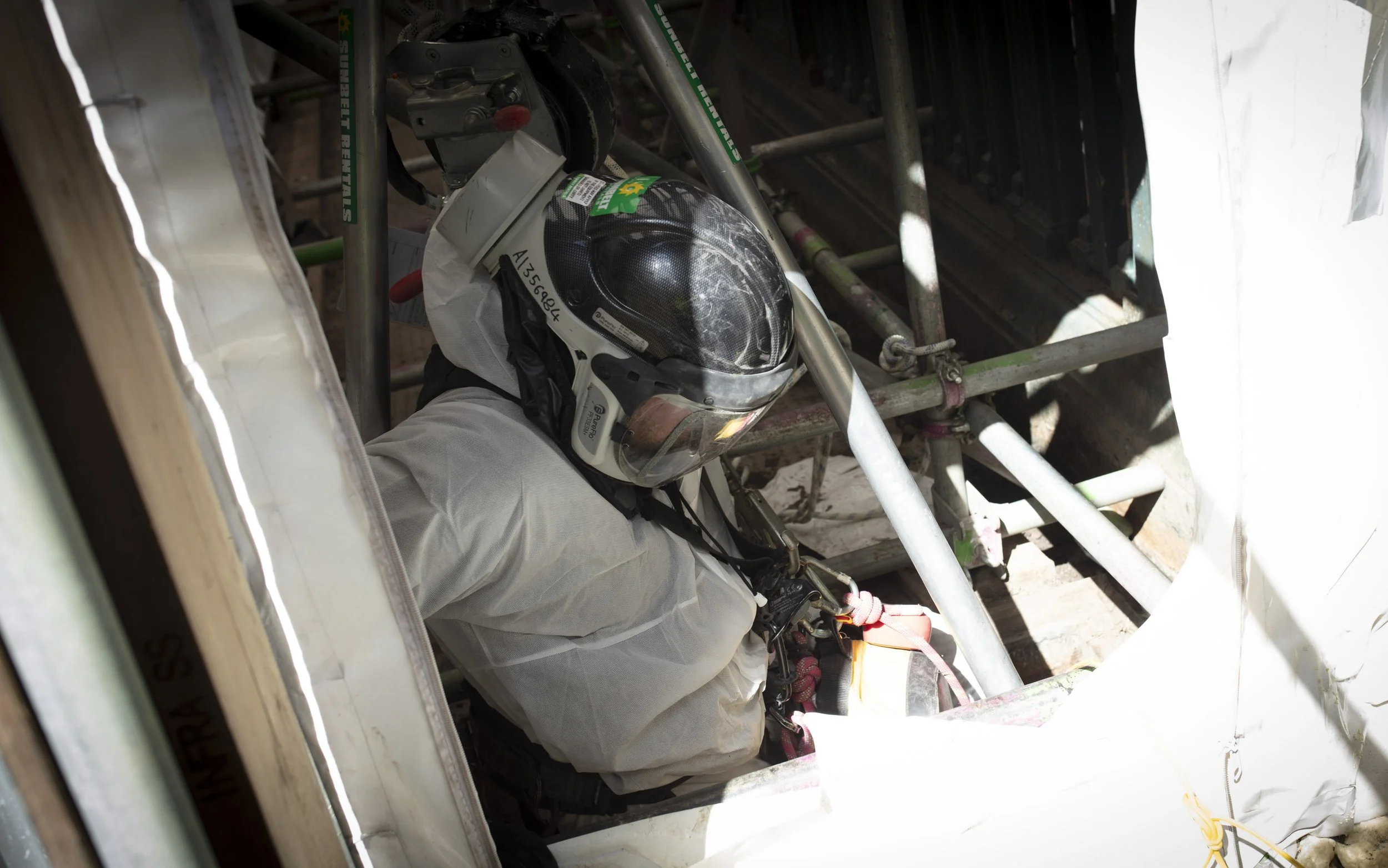A peek behind the hoardings five weeks into the restoration
Over the last five weeks, appointed contractor, Esh Construction, has started on the 900 steelwork repairs that are required to preserve the Grade II* listed structure for future generations.
Image Credit: Andrew Heptinstall Photography
Operatives are currently working within the tight confines of the 1.5m high bridge deck void, which is under the footway, where a full clean-up operation will remove dirt, rust and pigeon guano to provide a safe working environment for essential structural repairs to be carried out on the bridge hangers.
To access the void, operatives first had to break out the footway surfacing and lift the bolted down steel buckle plates on the east footway.
At the same time, within the encapsulated scaffold adjacent to the Gateshead tower, more cleaning is taking place to clear the steelwork of foreign matter and hazardous substances before grit blasting can take place to remove over 96 years’ of previous paint coatings. Once this is complete, repairs will be made and then repainting can take place. Due to its Grade II* listed status, the paint colour used will be British Standard BS14C39 or ‘Greenwood’, which is a colour as close to the original as possible (British Standard BS4800).




It is expected to take up to 12 months to complete the structural repairs to the east side of the bridge deck, before moving on to the west side of the bridge to carry out similar works. Once both sides are complete the emphasis will move onto the main arch.
The restoration programme has been carefully planned over the four-year period, with parts of the bridge to be scaffolded in around 20 phases, to allow the repair and painting works to be carried out safely. The scaffolding will be removed as each section is completed to maintain the required loading capacity.
To carry out the work safely and to protect the workforce and the public, the Tyne Bridge, which is used by up to 70,000 vehicles a day, has been reduced to one lane in each direction, effectively halving the capacity of the route at peak hours. These lane restrictions will be in place for a minimum of two years as the iconic structure is fully restored.
Council teams are monitoring the impact of the restoration works on the wider network, and so far, traffic seems to be coping well with maximum delays of up to 20 minutes at peak time on the approaches to the Tyne Bridge, as people heed the travel advice and make alternative arrangements.
Cllr Marion Williams, cabinet member for a Connected, Clean City at Newcastle City Council said: “This is the first phase of the restoration works to our iconic Tyne Bridge, with operatives working behind the scaffolding and within the footway voids on the main bridge deck.
“It’s a tight squeeze for the those working within the narrow bridge void as cars travel above, but we’re making good progress. We know how important this work is to the people of the region and we will be keeping you fully updated throughout the restoration period.
“We’d like to thank everyone who has followed the travel advice, and please continue to do that by using alternative routes, taking the park and ride options, or making the switch to public transport, to help keep Tyneside moving.
“It is a long four-year programme, but these vital works are needed to preserve this much-loved landmark for the future, and we can’t wait to see it shining in the Tyneside sky again.”
Councillor John McElroy, cabinet member for the environment and transport at Gateshead Council, said: “It’s great to see this vital project progressing well. There has been a lot of understanding about the vital nature of the restoration, and we are grateful that people are listening to the travel advice and keeping the transport network moving.”
Stephen McClean, Special Projects Construction Manager at Esh Construction, commented: “We were eager to get started on the restoration and have hit the ground running within the first month.
“A lot of the work we’re doing isn’t visible at this stage to members of the public as it takes place behind the encapsulated hoarding as well as in the bridge deck void.
“As people drive, walk or wheel across the bridge, our team are working within confined space conditions which only reach a maximum height of 1.5 metres, and in many sections of the bridge deck void where we clamber and crawl over beams, joints and pipework, the space becomes even more cramped.
“We are keen to share behind the scenes updates as much as possible throughout the restoration.”



The full £32m programme of works to the Tyne Bridge includes steelwork repairs, grit blasting and re-painting, concrete repairs, drainage improvements, stonework and masonry repairs, bridge deck waterproofing and resurfacing, parapet protection and bridge joint replacement.
A number of improvements to public transport, walking and cycling routes have been put in place to encourage people to use these forms of travel to help ease traffic congestion.
The four-year programme is expected to be complete in Summer 2028, ahead of the bridge’s centenary in October 2028.
The Tyne Bridge restoration is funded by the UK Government, as well as monies from both Newcastle City Council and Gateshead Council.
The Government signed off £35.2 million on 2 February 2024 towards the cost of two projects: the restoration of the Tyne Bridge and the Central Motorway upgrade. The two councils still await confirmation of the remaining £6 million which was announced as part of the Network North plan in October.

